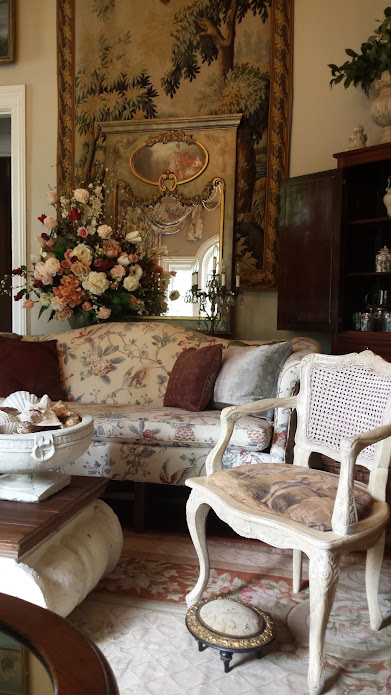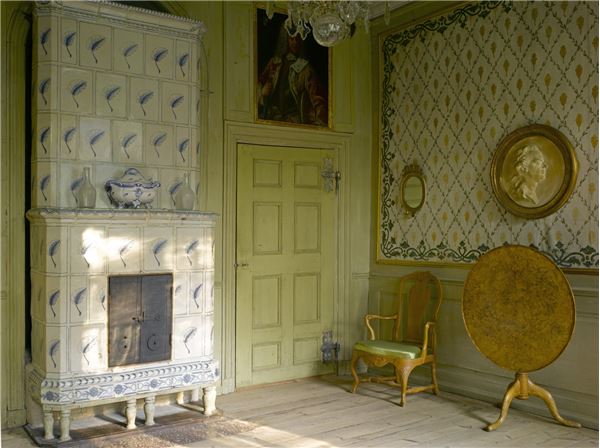I published a blog post about my French living room several years ago. But that was before I finally found the pièce de résistance I had been searching for that would put the finishing touches on the room and change the whole look and feel of the space. I was thrilled to have found the perfect French Aubusson needlepoint rug at an incredible (almost unbelievable ) price at an estate auction. The colors are lovely and muted to just the right shades on a wonderful cream background and the floral and fruit filled center oval was made for the room. I had a beautiful antique oriental rug down in shades of muted madder red, navy, gold and green but it didn't do for the room what this rug does. I know now that it is true, an Aubusson on the floor or on the wall changes everything!!
Lisa Farmer-Eye For design
My husband Tim laying the rug after I returned from Columbus Ohio. It was a six hour trip but the rug was worth it. Can you believe I got this beauty for $108.00?
Lisa Farmer-Eye For Design
The Aubusson rug softened the room, made it lighter and appear larger. The mantle was not in the house when purchased. I found it at and old antique/flea mall. Hard to see here but it has shields carved into it. All other mantle in the house work but this had been covered up with drywall. I bought an old tin summer cover and then faux painted tile around it.
Lisa Farmer-Eye For Design
The chair had been natural wood but the new look called for it to be painted. Rooms will talk to you you know. Since I only paid $20.00 for it at a yard sale I didn't mind painting it. I painted it three shades of cream topped of by wax. I also had to redo the silk flower arrangement in softer colors.The seat I upholstered with an old tapestry that I was not using. Part of it is now on the bench in front of the window. The little footstool is needlepoint and many people have said it reminds them of a cameo.
Lisa Farmer-Eye For Design
Tapestry and trumeau mirror were purchased at estate auctions. You can find unbelievable prices at these!!
Lisa Farmer-Eye For Design
This images give you a good look at the corner designs on the Aubusson. The piece in the corner was the first antique I ever bought at 19 years old. My first paycheck went to put it on lay-away at a local antique store. On the top is a recent great find at a fabulous price. It is two French military hats, sash, gloves, and epaulets..... all in a leather case. The large one sits atop an antique milliners linen head for wig displays.
Lisa Farmer-Eye For Design
Here you can see just how pretty the center medallion of the Aubusson is.
Lisa Farmer-Eye For Design
I also added the French altar candelabra this year. It is actually one of a set, the other is in my bedroom.
Lisa Farmer-Eye For Design
Another fun find is this beautiful accordion that I found in the basement of an old antique mall in Georgetown, KY. It was in the 50% off corner. It was filthy and after a good cleaning has become display worthy.
Lisa Farmer-Eye For Design
It is made by Augusto Torio and Sons, NY. Torio came to America from Italy and became one of the first accordion manufacturers in New York City.
Lisa Farmer-Eye For Design
Here you can see the border of the Aubusson rug. You can also see out into my hall from here. I faux painted the walls to resemble limestone several years ago.
Lisa Farmer-Eye For Design
Behind this desk is a French curio filled with my collections of Limoges boxes, antique compacts, various miniatures, and my favorites, the petit point purses. I love the French inspired ones with Watteau style images of lovers in pastoral settings. The style and colors of these purses are another reason the Aubusson needlepoint rug looks so good in here.
Lisa Farmer-Eye For Design
The purses are so beautiful, wish you could see them in person. They are each approximately 5 X 6 inches and so delicate, some with beads, and intricate clasps.
Lisa Farmer-Eye For Design
I love needlepoint and the smaller stitches of petit point and collect all I can find whether it's purses, pictures, tapestries, covered chairs, or rugs. I have some great antique compacts too.
Lisa Farmer-Eye For Design
I have collected these for years and was able to buy them at a fraction for what they are now.
Lisa Farmer-Eye For Design
Lisa Farmer-Eye For Design
Here is an image of the living room during Christmas this year. I was always one who decorated three trees and my philosophy was "go big or go home." That has all changed the more old world my interiors have become. We like the simpler Christmas look now.
Lisa Farmer-Eye For Design
The Corinthian column top table was a fabulous find at a strange second hand shop most would be afraid to go into. I kid you not. My son was with me and even he was apprehensive. But look what I found for $25.00. It was paid for and in my SUV before you could blink your eyes!!
Lisa Farmer-Eye For Design
Lisa Farmer-Eye For Design
I just decorate my mantles, stairs, etc with greenery, lights and bows. Saves time and my back!! The picture of Marie Antoinette's children is in needlepoint and came from an old farmhouse in England.
Lisa Farmer-Eye For Design
Click here to see the previous post
This blog post was published by Lisa Farmer
























































